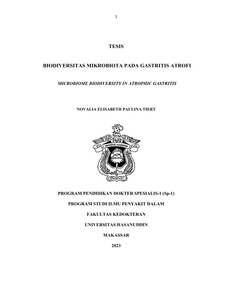Tiert, Novalia Elisabeth Paulina (2023) BIODIVERSITAS MIKROBIOTA PADA GASTRITIS ATROFI = MICROBIOME BIODIVERSITY IN ATROPHIC GASTRITIS. Thesis thesis, Universitas Hasanuddin.
![[thumbnail of Cover]](/33302/1.hassmallThumbnailVersion/C015182011_tesis_26-10-2023%20caver1.jpg)

C015182011_tesis_26-10-2023 caver1.jpg
Download (210kB) | Preview
C015182011_tesis_26-10-2023 bab 1-2.pdf
Download (2MB)
C015182011_tesis_26-10-2023 dp.pdf
Download (146kB)
C015182011_tesis_26-10-2023.pdf
Restricted to Repository staff only until 13 March 2026.
Download (2MB)
Abstract (Abstrak)
MICROBIOME BIODIVERSITY IN ATROPHIC GASTRITIS
Novalia EP Tiert, Muhammad Luthfi Parewangi, Rini Rachmawarni Bachtiar, Syakib Bakri, Wasis Udaya, Muhammad Ilyas, Arifin Seweng,
1Gastroentero-hepatology Division, Departement of Internal Medicine, Faculty of Medicine, Hasanuddin University, Makassar Indonesia, 2Gastroenterohepatology Centre Dr. Wahidin Sudirohusodo Hospital Makassar Indonesia, 3Department of Public Health and Community Medicine, Faculty of Medicine Makassar Indonesia, 4Hasanuddin University Medical Research Center Makassar Indonesia.
Introduction:
The microbiota in the human digestive tract plays an important role in maintaining body homeostasis. Differences in gut microbiota composition are closely related to susceptibility to various diseases, including inflammatory diseases, obesity, diabetes mellitus, cancer, and atherosclerosis.
Aims: This study was to determine the dominant microbiota population in patients with atrophic gastritis.
Subjects and Methods: This study used a cross sectional approach. (This was a cross-sectional study.) We collected 33 biopsy from atrophic gastritis subjects and 34 non atrophic gastritis subjects. The gastric microbiota from all samples were profiled by using 16s ribosomal RNA sanger sequencing Data analysis was carried out using SPSS version 25. (Statistical analysis was done using SPSS version 25.0 software.) The statistical analysis carried out was the calculation of descriptive statistics and frequency distribution.
Results: The description of the stomach microbiota genus shows that the majority are Acinetobacteria (44.7%), Escherichia (9.0%), Pseudomonas (9.0%) and Streptomyces (4%). In the phylum Proteobacteria (82.1%) it was found most often in non-atrophic and atrophic gastritis, while the least was Firmicutes (3%).
Conclusion: The composition of the microbiota in atrophic and non-atrophic gastritis is dominated by Acinetobacter, but in old age there are changes in the composition of the microbiota.
Keywords : atrophic gastritis, gastric microbiome, microbiome diversity
| Item Type: | Thesis (Thesis) |
|---|---|
| Uncontrolled Keywords: | atrophic gastritis, gastric microbiome, microbiome diversity |
| Subjects: | R Medicine > R Medicine (General) |
| Divisions (Program Studi): | Fakultas Kedokteran > PPDS Ilmu Penyakit Dalam |
| Depositing User: | S.Sos Rasman - |
| Date Deposited: | 28 May 2024 00:37 |
| Last Modified: | 28 May 2024 00:37 |
| URI: | http://repository.unhas.ac.id:443/id/eprint/33302 |


